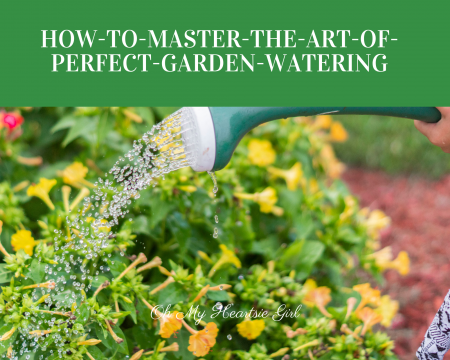One of the basic essentialities of any plant is water. Surviving for long without getting the desired quantity of water is difficult for plants. Therefore proper and timely irrigation is advised for flourishing them. While on the one hand watering the plant is necessary on the other hand, doing it with perfection is also important. One mistake and your plant could suffer and may even die. 
Therefore understanding the mechanics of watering and knowing when and how to water the plant is very important. So for every gardening enthusiast here we will provide with all the information which could help you master the art of perfect garden watering.
The Mechanics Of Watering
When you enter the garden with the mindset to water the plants, you require certain types of equipment. The kind of water breaker you uses determines the success of watering the plant. Although the market is flooded with many water breakers, getting the one which could deliver a soft stream of water with an apt volume to the plant is important. You also need to keep an eye on the water pressure. There could be chances when a sudden fluctuation in the water supply occurs. Too high pressure could cause the problem to the plant, and it may submerge. Therefore adjusting the water pressure and ensuring that a constant flow of water remains will bestow better results. You can also go for the selected garden hose for a perfect watering. Find top metal garden hoses here
How to water the plants
When we talk about ‘how to water’ every plant has its own set of requirements. While people feel easy to take the watering wand and pour water from the above, it is not a perfect way for all the plants. However, there are few instances when such practice is alright like when watering plug trays.
The few drawbacks of watering the plants in such manner include the following:
- By pouring water from above, the entire foliage gets wet. Only the top 1/4 to 1/2 inch of the substrate saturates, and rest of the pot remains wet. It leads to welcoming many crop diseases that thrive well in such conditions like Botrytis.
- Watering the plants at night in this way also retain the water in the pot for longer and encourage the development of diseases.
- This style does not wet the roots of the plant and the need to water again rises.
- Watering from above would not maintain the consistency which means some pots will remain under watered and some over watered.
Therefore it is advised to lower the breaker at a place little away from the roots of the plant in the soil surface. Watering each plant individually will give far better results. With this methodology, you could also control the amount of water going to each pot and save them from the probability of occurrence of diseases. Also, this is a great way to save water as well.
When To Water The Plants
Although the requirement of water varies from plants to plants, the grower needs to examine it as well. Watching out the substrate and noticing when it has dried and required water is crucial. At the same time, one should never over water the plant as it may rot the roots. A moderate watering, keeping an eye on the dryness of the substrate is, therefore, the best way to retain the health of the plant.
Moreover, if you can’t predict the need for watering just by seeing the substrate, you may use your hands to examine the same. All that you need is to pick random pots from the garden and see how heavy they feel. If you are finding them heavy even after witnessing the substrate dry, it would be better not to water it. Sometimes the soil dries only from above and underneath it is still wet.
How Much Water To Apply
For this, you need to examine certain conditions like:
- Size of the pot
- Stage of your crop
- Weather going to be next day
- Dryness of the crop
Both under watering and over watering could rot the plant and make your entire hard work futile. Therefore it is highly essential that you not only know your plant’s physiology and requirements beforehand but also how to water it. So, next time you enter the garden with a water wand, make sure you have understood the concept and science of watering.
This post contains affiliate links, which means I might receive a small commission if
you make a purchase using link.
Related:
Top 5 Best Pruning Tips to Transform Your Garden Into an Exquisite Place